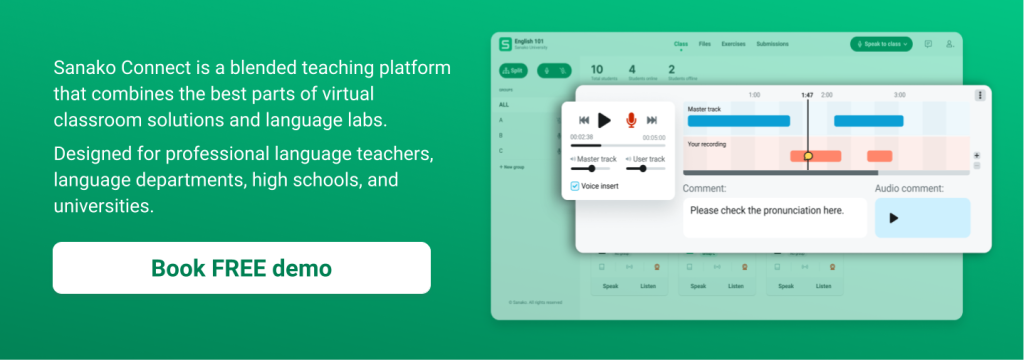All language learners come to that point where their knowledge and understanding is tested. For informal learners, this happens when they arrive in a country where their target language is spoken – it’s sink or swim as they try to communicate effectively. For language learners in formal education settings, this usually refers to pass / fail tests taken under exam conditions. For many high school students across the United States, their exams for College Board’s Advanced Placement Programme (AP®) are arranged every year in May.
This blog post therefore focuses on the World Language AP® exams and explores how staff can best support students with their exams. We’ll also touch upon how Sanako Connect software can help language teachers to create practice AP® exams using this web-based easy-to-use software tool.
What are the AP® courses?
If you’ve not heard of them before, the Advanced Placement Programme (AP®) enables “willing and academically prepared students to pursue college-level studies while still in high school.” The courses bring together a community of “teachers and students, states, districts, schools, colleges, and universities committed to the daily work of developing college-level knowledge and skills.” The courses were launched in 1955 and have since been taken by millions of students.
There are 38 AP® courses in seven subject categories. One of the categories is World Languages and Cultures, which includes courses on Chinese, French, German, Italian, Japanese as well as Spanish Language / Literature and Culture.
The course content consists of six units – see French as an example here – which institutions and staff can organise and teach as they wish. The courses all focus on building the same skills throughout their studies. These are:
- Interpersonal Communication: students “engage in conversations and discussions, express ideas, and exchange opinions using both spoken and written language.”
- Interpretive Communication: students aim to “understand and interpret written and spoken language on a variety of topics.”
- Presentational Communication: students “present information and ideas to an audience using spoken and written language.”
How are the AP® courses examined?
Similarly the courses are all examined in the same way – details of the Japanese exams can, for example, be found here. The AP® exams have consistent question types, weighting, and scoring guidelines every year, so that schools and students know what to expect on exam day. The format is as follows:
- Section IA: Multiple Choice Listening
- Section IB: Multiple Choice Reading
- Section IIA: Free Response Written (to include Interpersonal and Presentational Writing tasks)
- Section IIB: Free Response Spoken (to include Interpersonal and Presentational Speaking tasks)
Some thoughts on how to help students build the specific skills needed to succeed follow below.
How to build Interpersonal language skills
- Although the core purpose of this mode is about having conversations, it’s vital to remember that they need to have a purpose and a relevance. Otherwise, it’s just generating hot air and filling time. Think about why a conversation about X or Y is engaged and meaningful for your students.
- Use integrated performance assessments as part of your formative and summative assessment routine. Consider how comfortable / fluent students are when working through the task and how do they handle any gaps or mistakes they might make? How natural does the conversation feel or has it been scripted / memorised?
- Practice, practice, practice. Give students plenty of opportunity to talk and to progress to more complicated language / situations.
- Encourage them to record themselves and provide prompt feedback when asked. Provide peer examples of what different skill levels actually sound like and show where they can make improvements to progress.
How to build Interpretive language skills
- It’s essential to always use and focus on authentic sources that have been developed by / for native language speakers. This can and should include audio, film and text materials, which have been carefully tailored to the skills and proficiency of your student body. Maybe even get your students to choose some of the materials you use?
- In addition, try to find a wide variety of content for your students to review. Students will need to be able to understand and interpret menus, timetables, charts, graphs as well as text heavy content such as interviews and newspaper articles.
- Try to combine / test more than one skill at a time – prioritise resources and exercises that offer opportunity for students to listen and read. This will necessarily involve multiple sources which students can use to present different points of views or to pull together multiple points to create a more compelling response.
- Again use integrated performance assessments as part of your formative and summative assessment routine. Deployed throughout the course these can help to build experience and to get students ready for the actual AP® exams. Such assessments are great ways to build key skills such as skim reading and to tackle AP® level questions around themes, purpose and tone of the resources.
How to build presentational language skills
- It’s essential to provide a real-life context within which presentational skills can be developed. Try to ensure that the resources and scenarios you use relate to scenarios that students will appreciate / understand and, of course, which help build exam experience.
- It’s important that your assessments for these skills also focus on engagement and persuasion. Grammar and vocabulary are important, but does their language convince you or make you change your mind?
- In the exam, students will have four minutes to prepare and can draft a script / notes to use. Practice using this timeframe and provide a framework within which a coherent structure can be developed. Help them to build up a bank of useful phrases, which can be readily used whatever the question.
- As above, provide opportunities for students to practise and give them access to a library of other presentations to review and learn from. This could be on their own, in pairs or as part of a group. It’s also important to take the stress out of these situations, so consider how students’ presentational skills could be developed without always relying on a big presentation. This blog post on building confidence using asynchronous speaking practice has lots of great examples.
How can Sanako help your students to prepare for their World Languages AP® exams?
Sanako Connect, the market-leading language teaching tool, is well positioned to help educators and institutions prepare their students for the AP® exams.
It facilitates two important use cases. Firstly, Connect enables educators to create a simulated version of the actual online test environment helping students to build familiarity and confidence. Secondly students can use Connect to practise AP® exam activities on their own, either at home or in the classroom.
Further details on how to set up Connect to facilitate these scenarios can be found on YouTube or via this downloadable PDF.
If you’d like to find out more about how Sanako Connect language teaching platform could transform your approach to language teaching, please contact us now to arrange your FREE demo!

